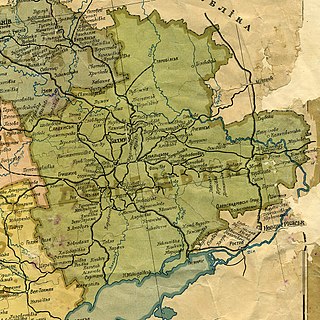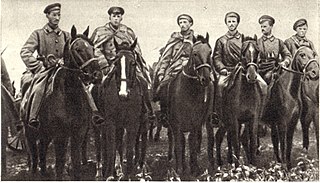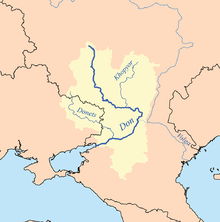
The Russian Civil War was a multi-party civil war in the former Russian Empire sparked by the overthrowing of the social-democratic Russian Provisional Government in the October Revolution, as many factions vied to determine Russia's political future. It resulted in the formation of the Russian Socialist Federative Soviet Republic and later the Soviet Union in most of its territory. Its finale marked the end of the Russian Revolution, which was one of the key events of the 20th century.

Andrei Grigoriyevich Shkuro was a Russian military officer of Cossack origin, lieutenant general (1919) of the White Army.

The Southern Front was a military theatre of the Russian Civil War.

The Don Army was the military of the short lived Don Republic and a part of the White movement in the Russian Civil War. It operated from 1918 to 1920, in the Don region and centered in the town of Novocherkassk.

The Orel–Kursk operation was an offensive conducted by the Southern Front of the Russian Soviet Federative Socialist Republic's Red Army against the White Armed Forces of South Russia's Volunteer Army in Orel, Kursk and Tula Governorates of the Russian Soviet Federative Socialist Republic between 11 October and 18 November 1919. It took place on the Southern Front of the Russian Civil War and was part of the wider October counteroffensive of the Southern Front, a Red Army operation that aimed to stop Armed Forces of South Russia commander Anton Denikin's Moscow offensive.

The Armed Forces of South Russia (AFSR or SRAF) (Russian: Вооружённые силы Юга России, romanized: Vooruzhyonniye sily Yuga Rossii, VSYuR) were the unified military forces of the White movement in southern Russia between 1919 and 1920.

Donets Governorate was a governorate of the Ukrainian SSR (Ukraine) that existed between 1919 and 1925.

The Battle of Tsaritsyn was a military confrontation between the Red Army and the White Army during the Russian Civil War for control of Tsaritsyn, a significant city and port on the Volga River in southwestern Russia.
The North Caucasus Operation was a strategic offensive conducted by the Caucasian Front of the Red Army against the White Armed Forces of South Russia in the North Caucasus region between 17 January and 7 April 1920. It took place on the Southern Front of the Russian Civil War and was a Soviet attempt to destroy White resistance.

The Donbas-Don operation was a military campaign of the Russian Civil War that lasted from January to February 1918, by forces of the Southern Revolutionary Front under the command of Vladimir Antonov-Ovseyenko, against the Cossack troops of Alexey Kaledin and Volunteer detachments on the territory of the Donbas and the Don Cossack region. It was the decisive operation in the complete conquest of Russia by the Bolsheviks following the October Revolution.

The Southern Front was a front of the Red Army during the Russian Civil War, formed twice.
The Voronezh–Povorino Operation, was a battle in January 1919 between the White and Red Armies during the Russian Civil War around the city of Voronezh and the railway station of Povorino. The Red Army defeated the Don Army under Pyotr Krasnov.

The battle for Donbas was a military campaign of the Russian Civil War that lasted from January to May 1919, in which White forces repulsed attacks of the Red Army on the Don Host Oblast and occupied the Donbas region after heavy fighting.

The Northern Taurida operation was a military campaign in the Russian Civil War between the Red Army and the White Army under Pyotr Wrangel for the possession of Northern Taurida. The campaign can be divided into 3 stages: the White offensive, trench warfare around the Kakhovka Bridgehead and the counterattack of the Red Army.

The August counter-offensive of the Southern Front was an offensive during the Russian Civil War by the troops of the Southern Front of the Red Army against the White Guard troops of Anton Denikin. Combat operations were conducted by two offensive groups, the main blow was aimed towards the Don region. The troops of the Red Army were unable to carry out the assigned task, but their actions delayed the subsequent offensive of Denikin's army.

The Rostov-Novocherkassk operation was an offensive operation on the Don River of the Southern and the South-Eastern Front the Red Army against the White Guard troops during the Russian Civil War.

The Kharkiv operation was an offensive during the Russian Civil War by the Southern Front of the Red Army under the command of Alexander Yegorov against the White Guard troops of Anton Denikin.

The Voronezh-Kastornoye operation was an offensive operation by the Red Army during the Russian Civil War in October and November 1919, which was successfully carried out by parts of the 8th and 13th Army, which formed the left wing of the Southern Front.

The Advance on Moscow was a military campaign of the White Armed Forces of South Russia (AFSR), launched against the RSFSR in July 1919 during the Russian Civil War. The goal of the campaign was the capture of Moscow, which, according to the chief of the White Army Anton Denikin, would play a decisive role in the outcome of the Civil War and bring the Whites closer to the final victory. After initial successes, in which the city of Oryol at only 360 kilometres (220 mi) from Moscow was taken, Denikin's overextended Army was decisively defeated in a series of battles in October and November 1919.
Mikhail Arkhipovich Fostikov was a Cossack officer in the Imperial Russian Army and an officer of the counterrevolutionary White movement during the Russian Civil War, reaching the rank of lieutenant general.
















